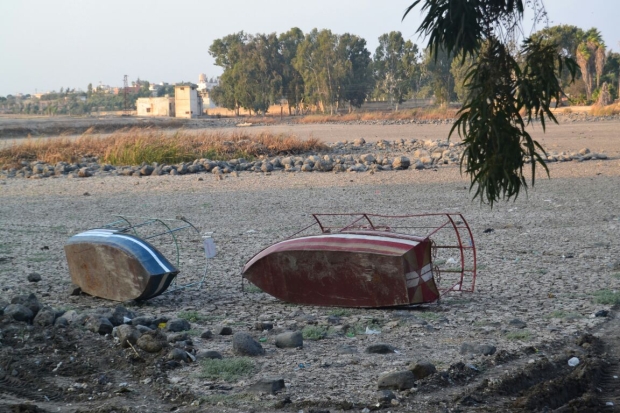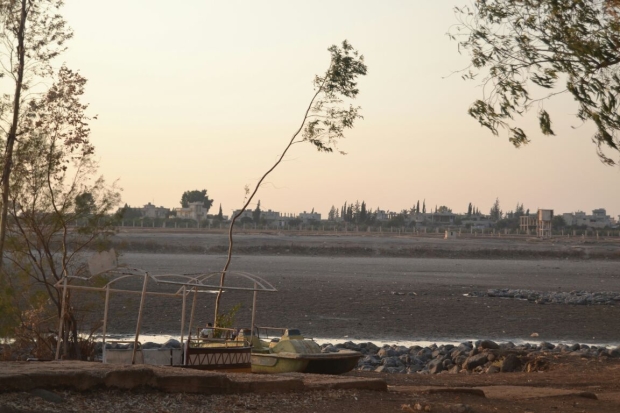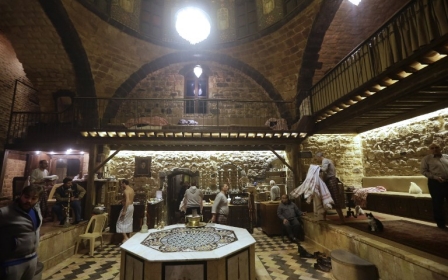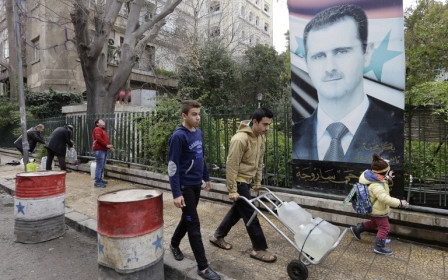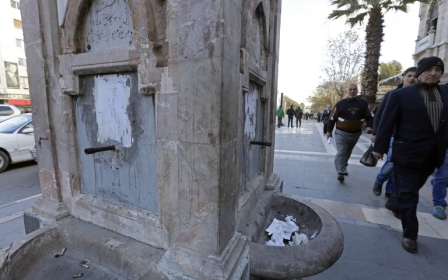Draining a lake in Daraa: How years of war caused Muzayrib to dry up

AMMAN, Jordan - Wooden boats lie scattered on the sunbaked mud of Lake Muzayrib, just 11 kilometers northwest of Daraa city, in a rebel-controlled part of southern Syria.
The lake, which has all but disappeared, was the largest natural body of water in Daraa province, feeding parts of Daraa city and neighbouring villages with drinking water. It also fed the area’s agricultural sector and fish farms.
For three years residents have watched the lake slowly wither from a half-kilometre in width to puddles, hoping rain would replenish the depleting waters.
“There is no work and no way, aside from the lake’s water, to make a living here,” Muhammad, a wheat farmer from Muzayrib who requested only his first name be used, told Middle East Eye.
While the civil war has exacerbated water shortages across Syria, several researchers have linked an extreme drought in Syria between 2006 and 2009 - the worst in the country in modern times – to the emergence of the 2011 protests, though rainfall levels in Daraa province recovered between 2008 and 2009.
If I had an alternative source of water, I would have used it, but we need to live and I need to feed my children
- Muhammad, Daraa resident
Daraa’s rural economy, largely reliant on agriculture, has been choked by war, with government forces controlling one third of the province and most of neighbouring Suwayda province. The import of goods has slowed, along with any potential economic activity that remains.
This has left many with no option aside from farming, according to residents living around Muzayrib.
“If I had an alternative source of water, I would have used it, but we need to live and I need to feed my children.”
But now without the lake to water his wheat crop Muhammad has been forced to search for a new source of income.
Too many wells
Water experts in Daraa caution that Lake Muzayrib’s dilemma runs deeper than the pumps near the lake. Muzayrib’s dried lakebed, stark as it is, brings into focus the precarious and increasingly dire state of Daraa province’s groundwater.
Ali al-Buqayrat, a Syrian water expert working in opposition-controlled territory in Daraa province, has been watching this crisis unfold for years.
“The lake drying up indicates that the springs’ flow has been greatly reduced,” Buqayrat told MEE, adding that he has been seeing a decrease in one of the feeder springs since 1984, when the flow was “900 litres per second, whereas in 2005 the flow was measured at 720 litres per second”.
The main reason behind the drying of the lake is the spread of unregulated wells in the region
- Ali al-Buqayrat, Syrian water expert
“The main reason behind the drying of the lake is the spread of unregulated wells in the region,” Buqayrat said. “The average depth of these wells has increased from 100 meters to 250 meters.”
Buqayrat fears that “the wells are drawing water not just from the confined aquifer but the unconfined aquifer as well, and this is the groundwater that feeds into the natural springs”.
Previous years would see the lake “fluctuate in accordance with the amount of rain, but it would never dry out. The fluctuations in both directions were slight,” said Anis al-Zubani, a water expert living in Daraa province.
Wider trend
Since 2011, when Syria’s revolution began in Daraa, defeats at the hands of rebel groups brought an end to the Assad government’s authority in most of Daraa province.
As the government’s control waned, so went its regulations.
Characterized in large part by nepotism, the ministries of agriculture and irrigation’s regulations for groundwater use and well-licensing practices were the subject of protests in Daraa in 2011, as grievances expanded initially from focusing on the arrest of 15 children to government corruption and other local issues.
Whenever the lake’s water level would go down, we’d say to ourselves, winter is just around the corner, and the rain will reset the water level. Now the lake has dried up and we have no crops
- Ali al-Buqayrat, Syrian water expert
In the years before the 2011 protests, the Syrian government, in partnership with a Russian researcher, funded a study in Daraa province that cautioned against the over-extraction of groundwater in the region, according to Anis Ghazawi, a member of Muzayrib’s local council.
“The study concluded that, in order to protect the lake, the government needed to prevent wells from being dug within 30 square kilometers of the lake,” said Ghazawi.
But since government influence and regulations have waned in large swaths of Daraa, the number of wells has increased by the thousands.
“Between 2011 and 2017 the number of wells [in Daraa province] has proliferated from 8,000 to 20,000,” Buqayrat estimated.
“These wells have popped up in Tafa, Dael, Abbtaa, West and East Al-Gharaya, Al-Hirak, Al-Musayfra, even in Suwayda and Quneitra province.”
In 2014, Yousef, a tomato and eggplant farmer in Muzayrib, dug his first irrigation well.
“I invested everything I owned to construct the well,” Yousef told MEE.
Before the war, Yousef said, “if you didn’t have connections to someone high up [in the ministries of agriculture or irrigation], it was impossible to get permission to dig a well".
Since the 2011 protests, control of the Syrian ministries of agriculture and irrigation in opposition-controlled parts of Daraa province has largely disappeared, and with them the importance of the personal connections once required to navigate their bureaucracies.
Before the war, if you didn’t have connections to someone high up, it was impossible to get permission to dig a well
- Yousef, farmer in Muzayrib
Equally important for farmers, the once prohibitive fees required to license a well - nearly one million Syrian pounds (about $21,285 according to the pre-civil war exchange rate) are no longer in place, said Yousef.
With 30 percent of Daraa’s one million residents displaced and a precarious calm in opposition-controlled Daraa, the local councils in the province have not created any laws regulating irrigation wells, according to Ghazawi.
“Even if they did, the war’s chaos would make them [regulations] impossible to enforce. To control and regulate wells would require a force across all of Daraa province,” Ghazawi said.
Water systems targeted
In many ways Lake Muzayrib follows a wider pattern of the deterioration of Daraa’s water systems.
With most dams in the province under the control of opposition forces, the resources, technical skills and institutional knowledge required to manage reservoirs and dams has by and large left the province.
At the same time, the issue goes far beyond a mere lack of institutional knowledge. Daraa’s water systems have been targets during the war as well.
In a bid to pressure opposition forces near Daraa city, government forces cut off the streams and water ways that flowed into the Daraa city dam from Suwayda province last summer.
Last year, a study conducted by the Jordan Water Project in part concluded that the direct targeting of dams and reservoirs by the government, as well as a dearth of operational knowledge on behalf of opposition forces, likely forced farmers across Daraa province to increasingly rely on groundwater rather than Daraa province’s many dams for irrigation.
The study went on to note that a lack of institutional capacity prevented opposition forces from preventing illegal well drilling.
“The decline of water resources has been gradual, and since it only affected irrigation, the problem went unnoticed. But this year the effects have become clear and have manifested themselves on Muzayrib and Zayzoun springs,” Buqayrat told MEE.
“Whenever the lake’s water level would go down, we’d say to ourselves, winter is just around the corner, and the rain will reset the water level.”
“Now the lake has dried up and we have no crops.”
New MEE newsletter: Jerusalem Dispatch
Sign up to get the latest insights and analysis on Israel-Palestine, alongside Turkey Unpacked and other MEE newsletters
Middle East Eye delivers independent and unrivalled coverage and analysis of the Middle East, North Africa and beyond. To learn more about republishing this content and the associated fees, please fill out this form. More about MEE can be found here.


